What'sNEW Apr - Jun 2023
| 29 Jun 2023 | What'sNEW about HGT


|
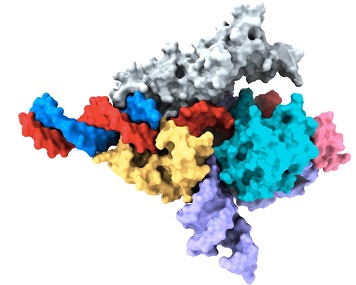 Eukaryotes appear to have a feature analogous to the CRISPR gene editing system in bacteria. The eukaryotic "Fanzor" enzymes are encoded within transposable elements. They were likely transferred from bacteria to eukaryotes. Pictured is a Cryo-EM map from the Zhang lab of a Fanzor protein complexed with RNA (purple) holding a target strand of DNA (red).
Eukaryotes appear to have a feature analogous to the CRISPR gene editing system in bacteria. The eukaryotic "Fanzor" enzymes are encoded within transposable elements. They were likely transferred from bacteria to eukaryotes. Pictured is a Cryo-EM map from the Zhang lab of a Fanzor protein complexed with RNA (purple) holding a target strand of DNA (red).
 "Programmable RNA-guided endonucleases are widespread in eukaryotes and their viruses," by Kaiyi Jiang et al., doi:10.1101/2023.06.13.544871, bioRxiv, online 14 Jun 2023. "Programmable RNA-guided endonucleases are widespread in eukaryotes and their viruses," by Kaiyi Jiang et al., doi:10.1101/2023.06.13.544871, bioRxiv, online 14 Jun 2023.
 "Fanzor is a eukaryotic programmable RNA-guided endonuclease," by Makoto Saito et al., doi:10.1038/s41586-023-06356-2, Nature, draft, 28 Jun 2023. "Fanzor is a eukaryotic programmable RNA-guided endonuclease," by Makoto Saito et al., doi:10.1038/s41586-023-06356-2, Nature, draft, 28 Jun 2023.
 "...CRISPR-like system in animals that can edit the human genome," by Leah Eisenstadt, MIT News, 28 Jun 2023. "...CRISPR-like system in animals that can edit the human genome," by Leah Eisenstadt, MIT News, 28 Jun 2023.
 "Fanzor: First CRISPR-Like System Found in Eukaryotes," Genetic Engeneering and Biotechnology News, 30 Jun 2023.
The new study demonstrates that RNA-guided DNA-cutting mechanisms are present across all kingdoms of life. "Fanzor: First CRISPR-Like System Found in Eukaryotes," Genetic Engeneering and Biotechnology News, 30 Jun 2023.
The new study demonstrates that RNA-guided DNA-cutting mechanisms are present across all kingdoms of life.
 Thanks, Google Alerts. Thanks, Google Alerts.
 Viruses... points to many examples of HGT to and among eukaryotes. Viruses... points to many examples of HGT to and among eukaryotes.
 Robust Software Management in eukaryotes is further exemplified by this gene editing feature. Robust Software Management in eukaryotes is further exemplified by this gene editing feature.
...all molecular clock estimates published to date indicate that animals began to diversify much earlier than fossils suggest. — Andrew Knoll, Life on a Young Planet, 2003
The mismatch between the apparent ages of genes – compared to the fossils that their expression would have left – is not going away. An international team of Earth scientists have a new theory to reconcile the mismatch, at least with respect to the genes for eukaryotic membrane sterols. Finding "abundant protosteroids in sedimentary rocks of mid-Proterozoic age," they envision a wholly separate eukaryotic phylogeny (illustrated in magenta) prior to the Last Eukaryotic Common Ancestor (LECA). All but one of its branches went extinct, leaving only chemical traces in ancient rocks.
 "Lost world of complex life and the late rise of the eukaryotic crown" by J.J. Brocks, B.J. Nettersheim, P. Adam et al., doi:10.1038/s41586-023-06170-w, Nature, 07 Jun 2023. "Lost world of complex life and the late rise of the eukaryotic crown" by J.J. Brocks, B.J. Nettersheim, P. Adam et al., doi:10.1038/s41586-023-06170-w, Nature, 07 Jun 2023.
 "Billion-year-old grease hints at long history of complex cells" by John Timmer, Ars Technica, 09 Jun 2023. "Billion-year-old grease hints at long history of complex cells" by John Timmer, Ars Technica, 09 Jun 2023.
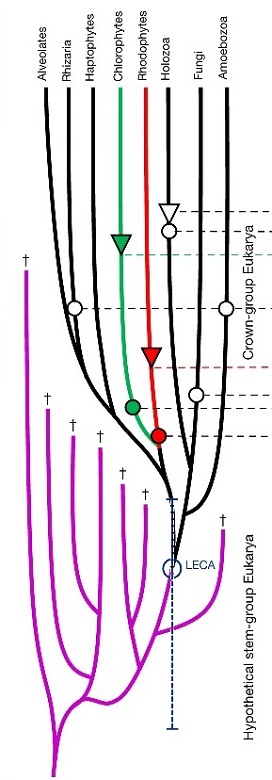
I admire the diligence of this research team, but I think mainstream neo-darwinism channels them to a fanciful conclusion. Yes, of course, lineages go extinct. But, as they know, genes may be transfered between branches or trees, and LECA becomes an elusive concept. Evidence that components of the sterols existed so early is intriguing, and other conclusions are available. Meanwhile, by cosmic ancestry, genetic programming always comes first and is assembled in blocks. Supporting evidence goes well beyond eukaryotic membrane sterols.
 08 Mar 2017: ...simple sterol biosynthesis existed well before the diversification of living eukaryotes.... 08 Mar 2017: ...simple sterol biosynthesis existed well before the diversification of living eukaryotes....
 Metazoan Genes Older Than Metazoa? has examples. Metazoan Genes Older Than Metazoa? has examples.
 Genes Older Than Earth? has examples. Genes Older Than Earth? has examples.
 The Tree of Life has related discussion. The Tree of Life has related discussion.
...with the finding of phosphates the ocean of Enceladus is now known to satisfy what is generally considered to be the strictest requirement of habitability.
 "Detection of phosphates originating from Enceladus's ocean" by Frank Postberg et al., Nature, 14 Jun 2023. "Detection of phosphates originating from Enceladus's ocean" by Frank Postberg et al., Nature, 14 Jun 2023.
 "A 'Soda Ocean' on a Moon of Saturn Has All the Ingredients for Life" by Katrina Miller, NYT, 14 Jun 2023. "A 'Soda Ocean' on a Moon of Saturn Has All the Ingredients for Life" by Katrina Miller, NYT, 14 Jun 2023.
 Science will not collapse if some practitioners are convinced that occasionally there has been creative input in the long chain of being. These are the words of Owen Gingerich, writing in 2005, about the ongoing conflict between Intelligent Design (ID) and the theory of evolution. He taught astronomy and history of science at Harvard for many years. He died, May 28.
Science will not collapse if some practitioners are convinced that occasionally there has been creative input in the long chain of being. These are the words of Owen Gingerich, writing in 2005, about the ongoing conflict between Intelligent Design (ID) and the theory of evolution. He taught astronomy and history of science at Harvard for many years. He died, May 28.
 "Owen Gingerich, 93, Who Delved Into the Cosmos and Saw God, Dies" [link], The New York Times, 12 Jun 2023. "Owen Gingerich, 93, Who Delved Into the Cosmos and Saw God, Dies" [link], The New York Times, 12 Jun 2023.
 "... intelligent design" [pdf], by Owen Gingerich, Science & Theology News, Nov 2005. "... intelligent design" [pdf], by Owen Gingerich, Science & Theology News, Nov 2005.
Gingerich is wrong to dismiss the deep schism between proponents and opponents of the theory of evolution. I agree with ID, the theory of evolution does not begin to explain how life or its genetic programming "originates." But "occasional input" from an immaterial source would undermine science. So I am somewhat relieved that Gingerich admits, "...frankly it lies beyond science to prove the matter one way or the other," although that suggests that the rift will never go away. Cosmic ancestry is a way to repair the theory of evolution. It follows scientific principles wthout insulting Gingerich's belief in a "created cosmos."
 Evolution versus Creationism has history, discussion and updates. Evolution versus Creationism has history, discussion and updates.
16 Jun: ID proponent Michael Behe comments, ...Sorry to hear Owen Gingerich has died. I met him once and he seemed to be a very nice guy. I'm not as worried as you are about "occasional input" undermining science. I'm more worried about science being undermined by people ignoring unwelcome data. Best wishes. Mike
PS From Brig: Cosmic ancestry provides "occasional input" by HGT, but it's not immaterial or supernatural.
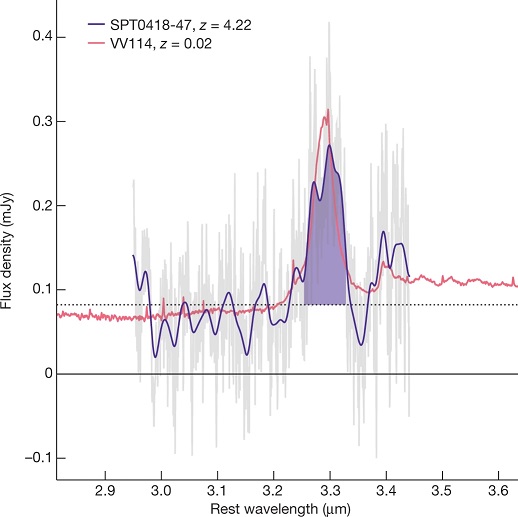 Detecting these complex organic molecules at such a vast distance is game-changing....
The dust within and around a galaxy 12 billion lightyears away is rich with complex organic molecules, and heavy elements are as abundant there as in our own solar system. The view of the galaxy with the James Webb Telescope was magnified 30x or more because of gravitational lensing by a near-perfectly aligned closer galaxy.
Detecting these complex organic molecules at such a vast distance is game-changing....
The dust within and around a galaxy 12 billion lightyears away is rich with complex organic molecules, and heavy elements are as abundant there as in our own solar system. The view of the galaxy with the James Webb Telescope was magnified 30x or more because of gravitational lensing by a near-perfectly aligned closer galaxy.
 "Spatial variations in aromatic hydrocarbon emission in a dust-rich galaxy" [link], by J.S. Spilker, K.A. Phadke, M. Aravena et al., doi:10.1038/s41586-023-05998-6, Nature, 05 Jun 2023. "Spatial variations in aromatic hydrocarbon emission in a dust-rich galaxy" [link], by J.S. Spilker, K.A. Phadke, M. Aravena et al., doi:10.1038/s41586-023-05998-6, Nature, 05 Jun 2023.
 "Webb Space Telescope detects universe's most distant complex organic molecules" [link], by Lois Yoksoulian, University of Illinois at Urbana-Champaign +Phys.org, 05 Jun 2023. "Webb Space Telescope detects universe's most distant complex organic molecules" [link], by Lois Yoksoulian, University of Illinois at Urbana-Champaign +Phys.org, 05 Jun 2023.
 Hoyle and Wickramasinghe's Analysis of Interstellar Dust. Hoyle and Wickramasinghe's Analysis of Interstellar Dust.
| 27 May 2023 | What'sNEW about HGT


|
One of the most effective and fast strategies for organisms to acquire new abilities is through horizontal gene transfer.
 "Genes and evolutionary fates of the amanitin biosynthesis pathway in poisonous mushrooms" [link], by Hong Luo et al., doi:10.1073/pnas.2201113119, PNAS, 09 May 2022. "Genes and evolutionary fates of the amanitin biosynthesis pathway in poisonous mushrooms" [link], by Hong Luo et al., doi:10.1073/pnas.2201113119, PNAS, 09 May 2022.
 "Distantly related mushrooms gained the ability to make toxin via horizontal gene transfer" [link], by Bob Yirka, Phys.org, 10 May 2022. "Distantly related mushrooms gained the ability to make toxin via horizontal gene transfer" [link], by Bob Yirka, Phys.org, 10 May 2022.
 Viruses... points to many examples of HGT to and among eukaryotes. Viruses... points to many examples of HGT to and among eukaryotes.
P. Kyle Stanford is a philosophy professor at UC Irvine, and Series Editor of the Oxford Studies in the Philosophy of Science. In Exceeding Our Grasp (2006 | book review), he argued that science has always suffered from "blind spots" that may stall its progress for decades and more. Others have since suggested that modern science has largely overcome that handicap. He thinks not. After World War II, professionalization, peer pressure, and conservatism from granting agencies are among the forces that make science even more orthodox and less progressive than earlier. His paper of 2015 gives an outline of the history of modern science with focus on this issue.
 "Unconceived alternatives and conservatism in science:
the impact of professionalization, peer-review,
and Big Science," by P. Kyle Stanford, doi:10.1007/s11229-015-0856-4, Synthese, 30 Aug 2015. "Unconceived alternatives and conservatism in science:
the impact of professionalization, peer-review,
and Big Science," by P. Kyle Stanford, doi:10.1007/s11229-015-0856-4, Synthese, 30 Aug 2015.
Today's scientific communities are almost certainly more effective vehicles for testing, evaluating, and applying theoretical conceptions of various parts of the natural world than were their historical predecessors, but ...they are actually less effective ...in conceiving, exploring, or developing fundamentally novel theoretical conceptions of nature in the first place.
For the Theory of Evolution, the problem of blind spots is even worse because the research is stuck on the wrong questions. Instead of origins they should look for sources. Interestingly, evolutionary scientists studying prokaryotic genomes are being turned toward this perspective by their own results. "New" genes are always observed to be supplied by transfer (HGT) from somewhere else; they are never witnessed to "originate." Why does the profundity of this development go unnoticed?!
 10 Mar 2021: New genes can be acquired only via HGT.... 10 Mar 2021: New genes can be acquired only via HGT....
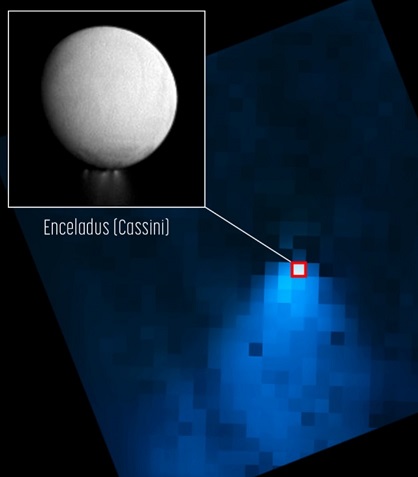 This enormous cloud might contain the chemical ingredients of life....
This enormous cloud might contain the chemical ingredients of life....
 "JWST spots biggest water plume yet spewing from a moon of Saturn," by Alexandra Witze, Nature, 18 May 2023. "JWST spots biggest water plume yet spewing from a moon of Saturn," by Alexandra Witze, Nature, 18 May 2023.
 "...Surprisingly Large Plume Jetting From ...Enceladus," Webb Space Telescope, 30 May 2023. "...Surprisingly Large Plume Jetting From ...Enceladus," Webb Space Telescope, 30 May 2023.
 Life on Europa, Other Moons, Other Planets?... has related links. Life on Europa, Other Moons, Other Planets?... has related links.
As defined here, microevolution is the process that explores the potential of installed genetic programming. Substitution of single nucleotides is the simplest way to do that. Chance copying errors were first believed to supply the nucleotide substitutions for testing, but by about 2005, "adaptive mutation," or increased mutation rates caused by stress, began to be noticed. Later, "directed mutation" was seen to focus the substitutions in the right places, and examples of convergent microevolution appear to confirm its effectiveness.
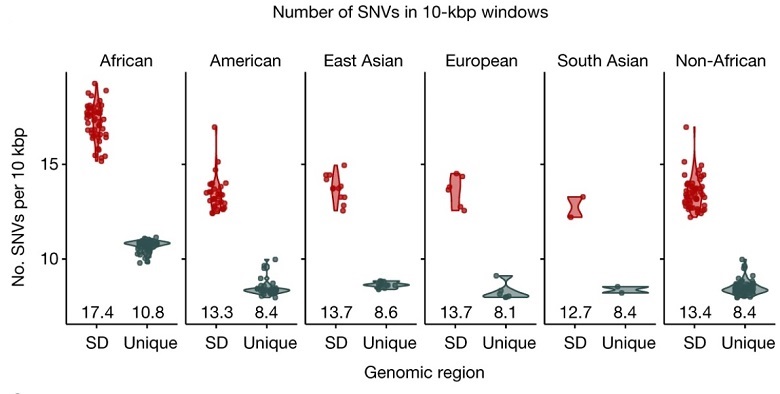 ...Concerted Evolution? A new study shows that duplicated human sequences have undergone accelerated point mutations. Single-nucleotide variant (SNV) density is significantly elevated (60%) in duplicated DNA when compared to unique DNA.... (Red and dark grey-green, respectively, in figure.) The team from The University of Washington School of Medicine and the UC Santa Cruz Genomics Institute estimate, "at least 23% of this increase is due to the action of interlocus gene conversion (IGC) between paralogous sequences that essentially diversify allelic copies through concerted evolution."
...Concerted Evolution? A new study shows that duplicated human sequences have undergone accelerated point mutations. Single-nucleotide variant (SNV) density is significantly elevated (60%) in duplicated DNA when compared to unique DNA.... (Red and dark grey-green, respectively, in figure.) The team from The University of Washington School of Medicine and the UC Santa Cruz Genomics Institute estimate, "at least 23% of this increase is due to the action of interlocus gene conversion (IGC) between paralogous sequences that essentially diversify allelic copies through concerted evolution."
 "Increased mutation and gene conversion within human segmental duplications," by M.R. Vollger, P.C. Dishuck,W.T. Harvey et al., Nature, 10 May 2023. "Increased mutation and gene conversion within human segmental duplications," by M.R. Vollger, P.C. Dishuck,W.T. Harvey et al., Nature, 10 May 2023.
The enhancement and targetting of nucleotide substitutions must come from the action of a genetic system that we are calling "robust software management" (RSM) in genomes. It would make microevolution far more efficient than mere chance. Now this new study observes enhanced substitutions among duplicated segments of human genes. "Gene conversion," first noticed as a repair system, appears to augment the process. They're calling it "concerted evolution."
 Robust Software Management [incomplete] has comments on this capability. RSM would also facilitate macroevolution, by managing the installation (and testing, rejection, mothballing, etc.) of newly acquired programming, which HGT can supply. RSM is well demonstrated in computers. Robust Software Management [incomplete] has comments on this capability. RSM would also facilitate macroevolution, by managing the installation (and testing, rejection, mothballing, etc.) of newly acquired programming, which HGT can supply. RSM is well demonstrated in computers.
 27 Aug 2019: a striking example of convergent microevolution. 27 Aug 2019: a striking example of convergent microevolution.
 26 Mar 2021: another possible example pertaining to the coronavirus. 26 Mar 2021: another possible example pertaining to the coronavirus.
 Duplication Makes A New Primate Gene? has discussion and links about sub- vs. neo-functionalization. Duplication Makes A New Primate Gene? has discussion and links about sub- vs. neo-functionalization.
 Why Sexual Reproduction? includes early remarks about Gene Conversion. Why Sexual Reproduction? includes early remarks about Gene Conversion.
 Macroevolutionary Progress Redefined... lists examples of macro- and microevolution. Macroevolutionary Progress Redefined... lists examples of macro- and microevolution.
De novo genes are ones with no discernable darwinian provenance; they seem to have come "from nowhere." By darwinian logic, they should not exist. Yet very many genes that contribute to macroevolutionary advances are now known to be de novo genes. Two evolutionary biologists in Germany consider how they may have evolved from scratch.

"We used a mutation rate of 7.8×10^-9 mutations per nucleotide position per generation." Sounds promising, and the research is deep. But they never ask the most basic questions. How likely is it that a strand of 1,000 random nucleotides will not be interrupted by a stop codon? About 10^-7. How likely is it that its protein product will be a working member of any of life's 10^12 known protein families. Maybe, with lots of room for variants, something like 10^-40. Unlikely, right?
A theory that anticipates de novo genes deserves consideration.
 "Neutral Models of De Novo Gene Emergence Suggest that Gene Evolution has a Preferred Trajectory," by Bharat Ravi Iyengar and Erich Bornberg-Bauer, Molecular Biology and Evolution, doi:10.1093/molbev/msad079,
03 Apr 2023. "Neutral Models of De Novo Gene Emergence Suggest that Gene Evolution has a Preferred Trajectory," by Bharat Ravi Iyengar and Erich Bornberg-Bauer, Molecular Biology and Evolution, doi:10.1093/molbev/msad079,
03 Apr 2023.
 ...De Novo Genes has background and links. ...De Novo Genes has background and links.
 08 May 2023: Lead author Barat Ravi Iyengar replies with comments. 08 May 2023: Lead author Barat Ravi Iyengar replies with comments.
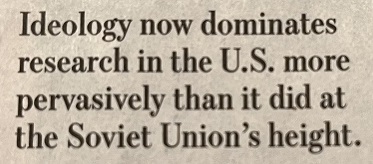 We ...warned of the consequences of taking an ideological approach to research. So write Jerry Coyne and Anna I. Krylov in Friday's Wall Street Journal. They are campaigning against a sociological movement that values "adherance to dominant progressive orthodoxies" over "established and effective practices of judging science based on its merit alone," they say.
We ...warned of the consequences of taking an ideological approach to research. So write Jerry Coyne and Anna I. Krylov in Friday's Wall Street Journal. They are campaigning against a sociological movement that values "adherance to dominant progressive orthodoxies" over "established and effective practices of judging science based on its merit alone," they say.
 "The 'Hurtful' Idea of Scientific Merit," by Jerry Coyne and Anna I. Krylov, WSJ, 28 Apr 2023.
Ideology of a different sort infects Coyne himself. Yes, life on Earth has evolved. But Coyne insists that today's theory of evolution is adequate to explain things it can't, like where new genetic programming comes from. He ignores the lack of proof and the doubts of many or most educated adults. He rules out the need for a serious alternative. None of this is unusual, but isn't it also an ideology? "The 'Hurtful' Idea of Scientific Merit," by Jerry Coyne and Anna I. Krylov, WSJ, 28 Apr 2023.
Ideology of a different sort infects Coyne himself. Yes, life on Earth has evolved. But Coyne insists that today's theory of evolution is adequate to explain things it can't, like where new genetic programming comes from. He ignores the lack of proof and the doubts of many or most educated adults. He rules out the need for a serious alternative. None of this is unusual, but isn't it also an ideology?
...clouds can transport these genes....
 "Scientists discover antibiotic resistance genes in clouds," Newswise, 27 Apr 2023; re: "Scientists discover antibiotic resistance genes in clouds," Newswise, 27 Apr 2023; re:
 "Quantification of antibiotic resistance genes (ARGs) in clouds at a mountain site..." [link], by Florent Rossi et al., Science of The Total Environment, 20 Mar 2023. "Quantification of antibiotic resistance genes (ARGs) in clouds at a mountain site..." [link], by Florent Rossi et al., Science of The Total Environment, 20 Mar 2023.
| 27 Apr 2023 | What'sNEW about HGT


|
Four evolutionary biologists observe in PNAS that yeast use autonomous transposons to accomplish horizontal gene transfer, much as bacteria use Integrative and Conjugative Elements (ICEs). Certain yeast transposons, which can transfer DNA strands of 300 kb or more, have been designated Starships. They often carry genes that are beneficial to the acquiring yeast, which may be a different species (see illustration, click for full image.)
Now this team has identified a specific recombinase that recognizes target sites for the Starship and facilitates insertion; they call it Captain. They also note that past contributions of HGT may be hard to detect because the clues degrade; HGT may be as important for yeast as it is for bacteria. "...Already implicated in chemical resistance, pathogenicity, and fungal domestication, the study of Starships represents an exciting avenue toward increasing our understanding of how fungi rapidly evolve numerous traits that impact upon human activities." Taking that avenue would be a breakthrough.
 "Starships are active eukaryotic transposable elements mobilized
by a new family of tyrosine recombinases" [link], by Andrew S. Urquhart et al., doi:10.1073/pnas.2214521120, PNAS, 06 Apr 2023. Also see: "Starships are active eukaryotic transposable elements mobilized
by a new family of tyrosine recombinases" [link], by Andrew S. Urquhart et al., doi:10.1073/pnas.2214521120, PNAS, 06 Apr 2023. Also see:
 "Giant Starship Elements Mobilize Accessory Genes in Fungal Genomes" [link], by Emile Gluck-Thaler et al., doi:10.1093/molbev/msac109, Molecular Biology and Evolution, 19 May 2022. "Giant Starship Elements Mobilize Accessory Genes in Fungal Genomes" [link], by Emile Gluck-Thaler et al., doi:10.1093/molbev/msac109, Molecular Biology and Evolution, 19 May 2022.
 Viruses... points to examples of HGT among yeast – and higher eukaryotes. Viruses... points to examples of HGT among yeast – and higher eukaryotes.
Intelligent Design (ID) sees that today's theory of evolution is deeply flawed. I generally agree with their critiques. Now, with informative commentary, a website promoting ID shows unusual interest in Starships and the power of HGT. Could cosmic ancestry at least supply the mechanism ID lacks? That would be a breakthrough!
 "Starship Enterprise: Fungal Transposons Boldly Go" [link], by David Coppedge, Evolution News, 26 Apr 2023.
It's time for eukaryotes like us to look at our transposons anew. "Starship Enterprise: Fungal Transposons Boldly Go" [link], by David Coppedge, Evolution News, 26 Apr 2023.
It's time for eukaryotes like us to look at our transposons anew.
 Thanks, Google Alerts. Thanks, Google Alerts.
 Evolution vs. Creationism has comments and links about ID. Evolution vs. Creationism has comments and links about ID.
 ...A Third Alternative (2003) has related discussion. ...A Third Alternative (2003) has related discussion.
 29 Apr 2023: my email to an anonymous proponent of ID: Common ground? 29 Apr 2023: my email to an anonymous proponent of ID: Common ground?
| 14 Apr 2023 | What'sNEW about HGT


|
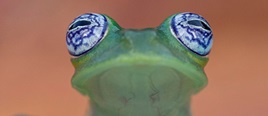 "Our work ...identifies recurrent iHGT of bacterial peptidase genes into eukaryotes and establishes the critical impact that acquisition of one such bacterial gene had on punctuating the evolution of the vertebrate eye.
"Our work ...identifies recurrent iHGT of bacterial peptidase genes into eukaryotes and establishes the critical impact that acquisition of one such bacterial gene had on punctuating the evolution of the vertebrate eye.
"...our data indicate that bacterial S41 peptidase genes have been acquired at least three independent times during eukaryotic evolution, including one instance that gave rise to vertebrate IRBP [interphotoreceptor retinoid-binding protein] and its unique role in the vertebrate visual cycle.
"Taken together, our work reveals further evidence that bacterial genes provide a rich source of evolutionary novelty, not just to other bacterial species, but to eukaryotes as well....
"...acquisition of foreign genetic material has the potential to punctuate eukaryotic evolution by providing immediate functional novelty."

| The top section shows the phylogenetic relationships of the Eukaryotes queried. Branches carrying IRBP are colored. The bar graph below it includes Bacteria (left) and measures the sequence similarity to IRBP in Vertebrates. |
 "Bacterial origin of a key innovation in the evolution of the vertebrate eye" [link], by Chinmay A. Kalluraya, Alexander J. Weitzel, Brian V. Tsu and Matthew D. Daugherty, doi:10.1073/pnas.2214815120, PNAS, 10 Apr 2023. "Bacterial origin of a key innovation in the evolution of the vertebrate eye" [link], by Chinmay A. Kalluraya, Alexander J. Weitzel, Brian V. Tsu and Matthew D. Daugherty, doi:10.1073/pnas.2214815120, PNAS, 10 Apr 2023.
 "An ancient gene stolen from bacteria set the stage for human sight" [link], by Elizabeth Pennisi, Science, 10 Apr 2023. "An ancient gene stolen from bacteria set the stage for human sight" [link], by Elizabeth Pennisi, Science, 10 Apr 2023.
 "Evidence found of possible interdomain horizontal gene transfer leading to development of the eye in vertebrates" [link], by Bob Yirka, Phys.org, 11 Apr 2023. "Evidence found of possible interdomain horizontal gene transfer leading to development of the eye in vertebrates" [link], by Bob Yirka, Phys.org, 11 Apr 2023.
 Thanks, Google Alerts. Thanks, Google Alerts.
 Viruses... lists other examples of interdomain horizontal gene transfer (iHGT) supplying evolutionary innovations.
It's time to acknowledge the importance of interdomain HGT in the evolution of eukaryotes. Viruses... lists other examples of interdomain horizontal gene transfer (iHGT) supplying evolutionary innovations.
It's time to acknowledge the importance of interdomain HGT in the evolution of eukaryotes.
17 Aug 2023: Maybe it was a single event of iHGT.
 "Horizontal transfer of vertebrate vision gene IRBP into the chordate ancestor," by Anthony K. Redmond and Aoife McLysaght, PNAS, 14 Aug 2023. "Horizontal transfer of vertebrate vision gene IRBP into the chordate ancestor," by Anthony K. Redmond and Aoife McLysaght, PNAS, 14 Aug 2023.
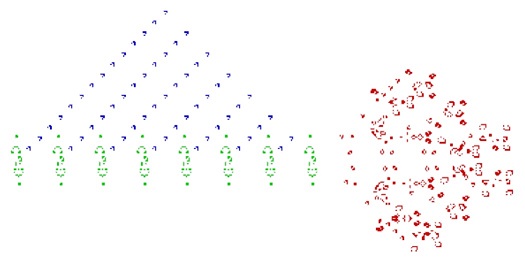 If evolution works like we've been told, a quarantined demonstration should be possible. If not yet in real life, then in a computer model, in "Artificial Life," the subject of a review in Scientific American. The article includes a small, delightful video from Conway's Game of Life, whose screen animation helped to rekindle interest in ALife. Following very simple digital instructions, critters seem to scurry, march or fly across the screen, as if alive.
If evolution works like we've been told, a quarantined demonstration should be possible. If not yet in real life, then in a computer model, in "Artificial Life," the subject of a review in Scientific American. The article includes a small, delightful video from Conway's Game of Life, whose screen animation helped to rekindle interest in ALife. Following very simple digital instructions, critters seem to scurry, march or fly across the screen, as if alive.
Theorists have wondered, could surprising, complex, emergent behaviour like that somehow produce new instructions that lead to increasingly complex emergent behaviour, without limit? Is that how life evolves? After much investigation ...apparently not. ALife is now pursuing research on multiple fronts, and the optimism of a decade or more ago is now muted. I wish they did not assume (as the article's writer does) that Earthly life is an actual quarantined demonstration. It's time to discard that assumption. Without it, evolution is open to a complete rethink. It needs that.
 "Life Evolves. Can Attempts to Create 'Artificial Life' Evolve, Too?" [link | animation], by Shi En Kim, Scientific American, 06 Apr 2023. "Life Evolves. Can Attempts to Create 'Artificial Life' Evolve, Too?" [link | animation], by Shi En Kim, Scientific American, 06 Apr 2023.
 Computer Models of Evolution is the first of six related webpages, including Computer Models of Evolution is the first of six related webpages, including
 The Evolution Prize, now dormant. It could return if there's demand. The Evolution Prize, now dormant. It could return if there's demand.
 03 Jun 2021: in email I suggest that human activity may exemplify emergence. 03 Jun 2021: in email I suggest that human activity may exemplify emergence.
 What Is Life? deals with the article's opening question. What Is Life? deals with the article's opening question.
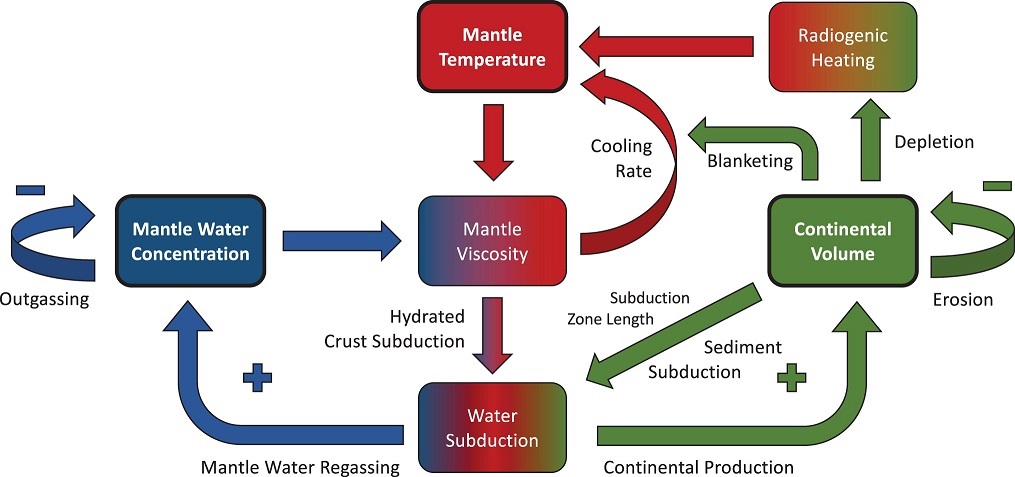 A balanced ratio of ocean to land is believed to be essential for an Earth-like biosphere.... A pair of experts on the evolution of planetary environments investigate this belief. Using extensive modelling, they conclude that a planet's environmental trajectory and habitability depend heavily on initial conditions — neither too much nor too little water. Needless to say, the conclusions are speculative. Critical processes include thermal blanketing and continental erosion, both influenced by life. Gaia is not mentioned, but I think this study honors James Lovelock's idea.
A balanced ratio of ocean to land is believed to be essential for an Earth-like biosphere.... A pair of experts on the evolution of planetary environments investigate this belief. Using extensive modelling, they conclude that a planet's environmental trajectory and habitability depend heavily on initial conditions — neither too much nor too little water. Needless to say, the conclusions are speculative. Critical processes include thermal blanketing and continental erosion, both influenced by life. Gaia is not mentioned, but I think this study honors James Lovelock's idea.
 "Land Fraction Diversity on Earth-like Planets and Implications for Their Habitability" [link], by Dennis Höning and Tilman Spohn, doi:10.1089/ast.2022.0070, International Journal of Astrobiology, 31 Mar 2023. "Land Fraction Diversity on Earth-like Planets and Implications for Their Habitability" [link], by Dennis Höning and Tilman Spohn, doi:10.1089/ast.2022.0070, International Journal of Astrobiology, 31 Mar 2023.
 "Intelligence as a planetary scale process" [link], by Adam Frank, David Grinspoon and Sara Walker, International Journal of Astrobiology, 07 Feb 2022.
What Earth Systems Science took from Gaia Theory was its recognition of the biosphere as a principal driver of planetary evolution.... "Intelligence as a planetary scale process" [link], by Adam Frank, David Grinspoon and Sara Walker, International Journal of Astrobiology, 07 Feb 2022.
What Earth Systems Science took from Gaia Theory was its recognition of the biosphere as a principal driver of planetary evolution....
 Gaia has history and updates. Gaia has history and updates.
| 07 Apr 2023 | What'sNEW about HGT


|
An interdisciplinary team affiliated with NASA asks how viruses may help our understanding and possible detection of life beyond Earth. They call the subject "astrovirology." For review, they also discuss the variety (see figure - click to enlarge), ubiqity, hardiness and promiscuity of viruses, citing many references.
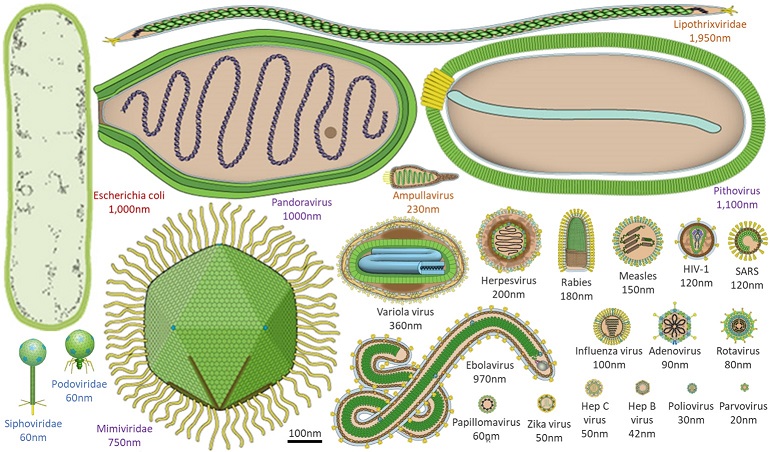 They notice, "viruses contain genetic information that can be transferred on massive scales." Some transfers have contributed significant features and capabilities to earthly life, and our genomes host abundant evidence of past transfers.
They notice, "viruses contain genetic information that can be transferred on massive scales." Some transfers have contributed significant features and capabilities to earthly life, and our genomes host abundant evidence of past transfers.
Ongoing HGT from viruses presents a puzzle to today's theory of evolution, yet it gets little mention. HGT and the astounding store of unknown genes in viruses could portend a huge paradigm shift. Might those genes affect future life? Could viruses be the primary source for evolutionary innovation? These astrovirologsts have turned their attention toward space, wth much to explore there as well.
 "Astrovirology: how viruses enhance our understanding of life in the Universe" [link], by Gareth Trubl et al., doi:10.1017/S1473550423000058, International Journal of Astrobiology, 05 Apr 2023. "Astrovirology: how viruses enhance our understanding of life in the Universe" [link], by Gareth Trubl et al., doi:10.1017/S1473550423000058, International Journal of Astrobiology, 05 Apr 2023.
 Viruses Drive Evolution: Kenneth M. Stedman et al., Jan 2018. Viruses Drive Evolution: Kenneth M. Stedman et al., Jan 2018.
 Viruses and Other Gene Transfer Mechanisms has many examples of viral genes that contribute to evolution. Viruses and Other Gene Transfer Mechanisms has many examples of viral genes that contribute to evolution.
Evidence for panspermia, and its philosophical implications are revisited, while new data from the James Webb Telescope suggest that there are galaxies much older that 13.8 billion years.
 Cosmology and the Origins of Life by N. Chandra Wickramasinghe, Jayant V. Narlikar and Gensuke Tokoro, Journal of Cosmology, posted 04 Apr 2023.
...the widespread distribution of biologically relevant molecules throughout the Galaxy and beyond is clear. It must come from life. Cosmology and the Origins of Life by N. Chandra Wickramasinghe, Jayant V. Narlikar and Gensuke Tokoro, Journal of Cosmology, posted 04 Apr 2023.
...the widespread distribution of biologically relevant molecules throughout the Galaxy and beyond is clear. It must come from life.
 Life beyond the limits of our planetary system by N. Chandra Wickramasinghe, Journal of Cosmology, posted 04 Apr 2023. Life beyond the limits of our planetary system by N. Chandra Wickramasinghe, Journal of Cosmology, posted 04 Apr 2023.
Introns are interruptions in eukaryotic genes that must be removed from the RNA transcript before it can be translated. They have been puzzling for the theory of evolution ever since they were first noticed, in 1977. A recent review includes a newly seen mechanism that can install them and duplicate itself, "Introners."
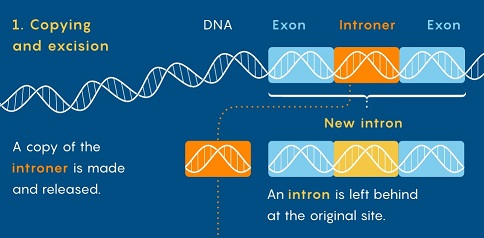
But the puzzle is no less puzzling today. The philosophy that relies on "selfish genes" and sees mostly "junk DNA" can only propose implausible accounting for introns. Introners deepen the mystery.
 How a DNA 'Parasite' May Have Fragmented Our Genes by Jake Buehler, Quanta Magazine, 30 Mar 2023. How a DNA 'Parasite' May Have Fragmented Our Genes by Jake Buehler, Quanta Magazine, 30 Mar 2023.
Introns make more sense if evolution is a constructive process that assembles blocks of instructions imported into the genome. This would require genomes to utilize robust software management capability, of which Introners look like an important component.
 Introns: a Mystery has an introduction and updates since 1996. Introns: a Mystery has an introduction and updates since 1996.
 Robust Software Management begins to develop this concept with examples. Robust Software Management begins to develop this concept with examples.
![]()
|
 Eukaryotes appear to have a feature analogous to the CRISPR gene editing system in bacteria. The eukaryotic "Fanzor" enzymes are encoded within transposable elements. They were likely transferred from bacteria to eukaryotes. Pictured is a Cryo-EM map from the Zhang lab of a Fanzor protein complexed with RNA (purple) holding a target strand of DNA (red).
Eukaryotes appear to have a feature analogous to the CRISPR gene editing system in bacteria. The eukaryotic "Fanzor" enzymes are encoded within transposable elements. They were likely transferred from bacteria to eukaryotes. Pictured is a Cryo-EM map from the Zhang lab of a Fanzor protein complexed with RNA (purple) holding a target strand of DNA (red).
 Science will not collapse if some practitioners are convinced that occasionally there has been creative input in the long chain of being. These are the words of Owen Gingerich, writing in 2005, about the ongoing conflict between Intelligent Design (ID) and the theory of evolution. He taught astronomy and history of science at Harvard for many years. He died, May 28.
Science will not collapse if some practitioners are convinced that occasionally there has been creative input in the long chain of being. These are the words of Owen Gingerich, writing in 2005, about the ongoing conflict between Intelligent Design (ID) and the theory of evolution. He taught astronomy and history of science at Harvard for many years. He died, May 28.


 We ...warned of the consequences of taking an ideological approach to research. So write Jerry Coyne and Anna I. Krylov in Friday's Wall Street Journal. They are campaigning against a sociological movement that values "adherance to dominant progressive orthodoxies" over "established and effective practices of judging science based on its merit alone," they say.
We ...warned of the consequences of taking an ideological approach to research. So write Jerry Coyne and Anna I. Krylov in Friday's Wall Street Journal. They are campaigning against a sociological movement that values "adherance to dominant progressive orthodoxies" over "established and effective practices of judging science based on its merit alone," they say.
 "Our work ...identifies recurrent iHGT of bacterial peptidase genes into eukaryotes and establishes the critical impact that acquisition of one such bacterial gene had on punctuating the evolution of the vertebrate eye.
"Our work ...identifies recurrent iHGT of bacterial peptidase genes into eukaryotes and establishes the critical impact that acquisition of one such bacterial gene had on punctuating the evolution of the vertebrate eye.


 A balanced ratio of ocean to land is believed to be essential for an Earth-like biosphere.... A pair of experts on the evolution of planetary environments investigate this belief. Using extensive modelling, they conclude that a planet's environmental trajectory and habitability depend heavily on initial conditions — neither too much nor too little water. Needless to say, the conclusions are speculative. Critical processes include thermal blanketing and continental erosion, both influenced by life. Gaia is not mentioned, but I think this study honors James Lovelock's idea.
A balanced ratio of ocean to land is believed to be essential for an Earth-like biosphere.... A pair of experts on the evolution of planetary environments investigate this belief. Using extensive modelling, they conclude that a planet's environmental trajectory and habitability depend heavily on initial conditions — neither too much nor too little water. Needless to say, the conclusions are speculative. Critical processes include thermal blanketing and continental erosion, both influenced by life. Gaia is not mentioned, but I think this study honors James Lovelock's idea.


 ...Concerted Evolution? A new study shows that duplicated human sequences have undergone accelerated point mutations. Single-nucleotide variant (SNV) density is significantly elevated (60%) in duplicated DNA when compared to unique DNA.... (Red and dark grey-green, respectively, in figure.) The team from The University of Washington School of Medicine and the UC Santa Cruz Genomics Institute estimate, "at least 23% of this increase is due to the action of interlocus gene conversion (IGC) between paralogous sequences that essentially diversify allelic copies through concerted evolution."
...Concerted Evolution? A new study shows that duplicated human sequences have undergone accelerated point mutations. Single-nucleotide variant (SNV) density is significantly elevated (60%) in duplicated DNA when compared to unique DNA.... (Red and dark grey-green, respectively, in figure.) The team from The University of Washington School of Medicine and the UC Santa Cruz Genomics Institute estimate, "at least 23% of this increase is due to the action of interlocus gene conversion (IGC) between paralogous sequences that essentially diversify allelic copies through concerted evolution."

